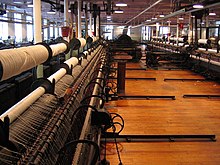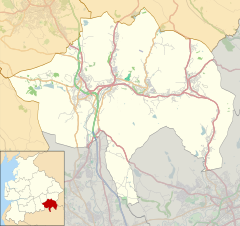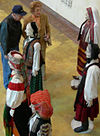Helmshore Mills Textile Museum
 Helmshore Mills Textile Museum | |
| Cotton Wool | |
|---|---|
| Alternative names | Higher Mill, Whitakerś Mill |
| Spinning mills | |
| Architectural style | Stone built 3 storey |
| Structural system | Stone |
| Owner | William Turner |
| Further ownership |
|
| Current owners | Lancashire Museums |
| Construction | |
| Built | 1789 |
| Floor count | 3 |
| Water Power | |
| Wheels | 2 Pitch back |
| Equipment | |
| Cotton count | 20 |
| Mule Frames | 4 per floor, Taylor, Lang &^Co Ltd, Stalybridge |
| Doublers | 1 |
Helmshore Mills are two mills built on the River Ogden in Helmshore, Lancashire. Higher Mill was built in 1796 for William Turner, and Whitaker's Mill was built in the 1820s by the Turner family.[1] In their early life they alternated between working wool and cotton. By 1920 they were working shoddy as condensor mule mills; and equipment has been preserved and is still used. The mills closed in 1967 and they were taken over by the Higher Mills Trust, whose trustees included Chris Aspin, the historian and author and Dr Rhodes Boyson who maintained it as a museum. The museum is open for visitors and does carding and mule spinning demonstrations. N.B.Following the withdrawal of its grant from Lancashire County Council this museum is threatened with closure in April 2016.
Location
Helmshore Mills lies within Helmshore, a village in the Rossendale Valley, Lancashire, England. It is situated 2 miles (3.2 km) south of Haslingden, broadly between the A56 and the B6235, approximately 16 miles (26 km) north of Manchester, and 3 miles (4.8 km) from the M65 motorway. Helmshore straddles the River Ogden a tributary of the River Irwell. The village developed around the 7 cotton and wool mills.
History
Before the mills were built, the Turner family had been involved in textiles. Three of the six brothers made their living from wool in Martholme and three from cotton in Blackburn. In 1789 the brothers built Higher Mill on a green field site in the parish of Musbury as a woollen fulling mill but the cotton brothers soon dropped out of the enterprise. It was the son of one of these original six, a William Turner (1793–1852) who built the larger mill in the 1820s. This was a wool carding, spinning and weaving mill. Some of the cloth would have gone to the fulling mill next door. Turner instructed in his will that the mill should be sold on his death, which occurred in 1852. This mill was destroyed by fire in 1857, and was rebuilt in 1860. It switched between wool and cotton several times. In the 1920s, the mill was bought by L.Whitaker & Sons who installed cotton condensing equipment and the mill continued in that business until Christmas 1978. Higher Mill came to be operated by Lawrence Whittaker in 1875 still using Turners machinery, and his descendants continued to run it as a fulling mill until June 1967. The two families may have been distantly related but by the 1920s the Whittakers were a well known local family while the firm of L.Whitaker & Sons no longer had any Whitakers working for them. The freehold of both mills in the Helmshore Mills Estate was bought by Lawrence Whittakers family.[2]
- The museum
When Rossall Whittaker died leaving no male heirs the Higher Mill was saved by local enthusiasts who recognised its significance and had it scheduled as an Ancient Monument, and through a trust bought it. Platt International, whose site was also in Helmshore, owned a significant collection of historic textile machines and agreed that they should be located in Higher Mill. The task of running a museum and maintaining the buildings put pressure on the trust, so in 1975 Lancashire County Council stepped in taking a 99-year lease. Whitaker's mill became vacant in 1976 and Lancashire County Council saw the advantages of having control of the two mills and bought the Condensor mill. This allowed them to also purchase the Platt collection in 1985, keeping the site intact and forming a comprehensive museum of the Lancashire Textile industry.[2]
In November 2015 Lancashire County Council announced it planned to cease its funding of the museum and shut to the public from 1st April 2016. In March 2016 the museum was granted a six month reprieve and will remain open to the public until 30th September 2016. Other operating models are being considered but the future of the museum beyond this date remains uncertain.
The mills
Higher Mill is a Grade II listed building [3]
The associated chimney stack on the other side of Holcombe Road is also separately Grade II listed.[4]
Condenser spinning
Template:Condenser spinning flowchart
Fine spinning produced a lot of waste so naturally this was recycled. This waste was the raw material of a condensor spinning mill. It came in three forms, loose staple, unspun rovings and spun thread (hard waste) that had been pirned but rejected. No matter its source it had to be devilled (broken down) to staple, then scutched and carded in the normal way. After these processes the staple was very short, and the processing of the lap was different - a Derby Doubler was used to mix slivers into sliver lap. A notable feature of the mule was that the rovings weren't on individual bobbins but on a beam. As the fine spinning of cotton contracted so did the need for condensing.
Boilers and chimney

When the steam engine was put in Whitaker mill, Lancashire boilers were ubiquitous. For maximum efficiency they required air to be drawn over the coals, and this was the function of the mill chimney. As these mills are set in a valley the air flow was irregular so the chimney was built in the hill opposite and the flue passed over the river and underground to reach the chimney. This provided the required updraught.
Water
Clean water was needed for processing the cloth. This was captured from field drainage on the hillside opposite and stored in a lodge on the farther side of the river, piped across when required. The Water wheel, and later the engine condenser could use the then highly polluted water from the River Ogden, a weir was placed 800m upstream and the water diverted into a long canal-like lodge that finished at the mill. Having passed over the pitch-back wheel the water passed through a culverted tail goyt back into the Ogden.
Museum exhibits
The museum divides its collections into three themed areas, representing the wool story, the cotton story and the spinning floor.
- The wool story
This shows the water wheel and fulling stocks and clay pots used to collect urine from the local cottages, that produced the ammonia needed for fulling. It goes on to show the later box system. There is a tenter frame, with the tenterhooks to show how the cloth was dried without shrinking and how teasles were used to lift up the nap. This was of course later mechanised and there is a teasle holding frame.
- The cotton story
This illustrates firstly the hand weavers cottage, with a frame loom with a hand thrown shuttle, mannikins represent the weaver and two women spinning the yarn on different types of wheel. A child is shown hand carding. It is here we see a 16 spindle spinning jenny that would have dated from about 1760, and a 50 spindle improved jenny. There is a replica of Arkwrights first carding machine. There is a complete sequence of machines that would have taken the bolls from the bales, opener, scutcher, breaker card, finisher card, draw frame and finally an Arkwright waterframe. Sharing the floor at Whitaker's Mill is the equipment needed to prepare the waste cotton for the cards in the room above. There is a single cylinder pisker for soft waste and a six cylinder devil for the hard waste.

- The spinning floor
This was one of two at this mill and has all the equipment to breaker card the shoddy (recycled cotton) and to finisher card the slivers into rovings, these go onto the 714 spindle Taylor Lang spinning mules. Opening, scutching and mixing happened on the floor below.
Spun yarn is sent to sister museum Queen Street Mill on the outskirts of Burnley to be woven.
Media
- North and South, BBC version [5]
See also
- List of mills in Lancashire
- Listed buildings in Haslingden
- Textile manufacturing
- Cotton Mill
- Queen Street Mill
References
- Notes
- ^ History and background
- ^ a b Spinning the Web.
- ^ "Name: HIGHER MILL MUSEUM List entry Number: 1072811". Historic England. Retrieved 10 March 2016.
- ^ "Name: CHIMNEY TO HIGHER MILL List entry Number: 1072812". Historic England. Retrieved 10 March 2016.
- ^ North and South, Mrs Gaskell, Richard Armitage
- Bibliography
- Ashmore, Owen (1982). The Industrial Archaeology of North-west England. Manchester University Press. ISBN 0-7190-0820-4. Retrieved 2009-06-25.
{{cite book}}: Invalid|ref=harv(help) - Catling, Harold (1986). The Spinning Mule. Preston: The Lancashire Library. ISBN 0-902228-61-7.
{{cite book}}: Invalid|ref=harv(help) - Chapman, S.J. (1904). The Lancashire Cotton Industry, A Study in Economic Development. Manchester.
{{cite book}}:|access-date=requires|url=(help); Invalid|ref=harv(help) - Gibson, Ian; Green (2011). "Helmshore Mills". Spinning the Web. Manchester City Council. Retrieved 17 May 2011.
- Haynes, Ian (1987). Cotton in Ashton. Libraries and Arts Committee, Tameside Metropolitan Borough. ISBN 0-904506-14-2.
{{cite book}}: Invalid|ref=harv(help) - Hills, Richard Leslie (1993). Power from Steam: A History of the Stationary Steam Engine. Cambridge University Press,. p. 244. ISBN 0-521-45834-X. ISBN 9780521458344. Retrieved January 2009.
{{cite book}}: Check date values in:|accessdate=(help); Invalid|ref=harv(help)CS1 maint: extra punctuation (link) - Nasmith, Joseph (1895). Recent Cotton Mill Construction and Engineering. London: John Heywood. ISBN 1-4021-4558-6. Retrieved March 2009.
{{cite book}}: Check date values in:|accessdate=(help); Invalid|ref=harv(help) - Nasmith, Joseph (1896). Students Cotton Spinning. London: John Heywood. Retrieved March 2011.
{{cite book}}: Check date values in:|accessdate=(help); Invalid|ref=harv(help) - Roberts, A S (1921), "Arthur Robert's Engine List", Arthur Roberts Black Book., One guy from Barlick-Book Transcription, retrieved 2009-01-11
{{citation}}: Invalid|ref=harv(help)
External links
- Helmshore Mills Textile Museum - Lancashire County Council
- Friends of Helmshore




